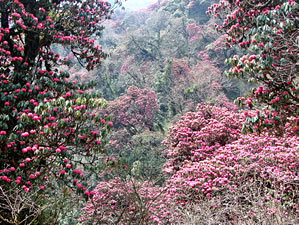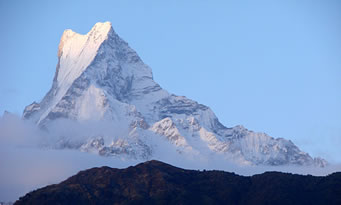The 5-day "Poon Hill Trek" is about 34 miles in length. It begins at a height of 3,312 ft. and reaches a maximum height of about 10,496 ft. at Poon Hill. Most of the paths were constructed by villagers hundreds of years ago.
Supplies for the villages are carried up these paths by porters and by pack mules. Justifiably, a liter of water that sells for about 24 cents in the cities, costs about $1.25 in the trekking villages. The porters earn about $10 per day for lugging as much as 65 to 70 pounds of goods on their backs up to the villages.
DAY
1: The walk started an hour's drive from Pokhara at a village called
Nayapool. We stopped at the top of the trail to buy our walking sticks - 20
Nepali rupees, and worth every bit of it - even Larry, who wasn't sure he
wanted one became a believer. So here we go - innocently down, down the hill
and then up, up, up for hours past our original stop at Tikhedhunga and onto
the next town, Ulleri. Our guide, Surya, said today's distance would make
the next day easier. It had better, because the last hour up almost killed
us.
Now, let me tell you about the trail. All of this mountainous area has terraces
built all the way up the hillsides, and the trail follows the terraces. These
amazing people have paved the terraced trails with slate flagstones - which
means you don't have to worry too much about mud, BUT you do have to climb
STEPS! It started out very hot, but as we got higher it cooled off, and then
became very cloudy. We arrived at our village at 3:15 pm and at 3:30, there
was a gigantic thunderstorm with rain and hail - we were so glad to be tucked
away at the tea house.
The tea houses have lodging and food - and a similar menu, so you end up eating
pretty much the same thing every day. However, the food is good, so it was
OK. They sometimes have electricity and sometimes have hot water, but not
usually at the same time. Sometimes the toilets are Western (meaning flush
toilets), but sometimes there are only Eastern toilets (a hole in the floor).
There is never any toilet paper and sometimes there is only a sink in which
to wash your hands. The tea houses are usually perched on the top of the hill
and have three or four levels to them - just what you want - more stairs!
But the views are spectacular!
The first day we walked along a creek all the way to the top - it looked very
much like Colorado, and I felt like a wimp being out of breath because the
altitude was only around 6,000 ft. The entire walk was through a rhododendron
forest. You wouldn't believe how big the rhododendron trees are - they are
really trees! They dot the hillsides with sudden colors of pinks and reds
- the way Aspens dot our hillsides in Colorado. The first day we thought we
had missed their time to bloom because most of the trees had lost their blossoms
- but it was OK because there were pink petals scattered all along our trail
and later when we got higher, we found that they were still in bloom and the
colors were brilliant - pink, rose and Chinese red. The forest is also made
up of some kind of evergreens and many deciduous trees. Further along we saw
orchids, holly and many, many, ferns.

The main reasons people take this trek is to see the rhododendrons and to see the Himalayas. While we could see the rhododendrons, we couldn't see the mountains. This time of year is the "burn time" during which people in the city and villages burn grasses and shrubs to encourage new growth after the monsoons. They were burning in Chitwan too. Anyway, the result of all this is a lot of pollution, so we couldn't see the mountains.
DAY
2: Day 2 began like day 1 ended -- straight up countless, additional
steps for the first two hours, before mercifully leveling off for stretches
between more ups and downs. We reached the picturesque village of Ghorepani
at 12:40 pm and were rewarded with spectacular views of the Annapurna range!
DAY 3: The next morning, we were supposed to get up at 4
am, climb a 90-degree hill of steps for one-and-a-half hours to reach Poon
Hill, where we could watch the sunrise touch the peaks of Annapurna, Fish
Tail and Dhaulagiri one-by-one. Apparently, as the sun rises it gradually
sets the whole range aglow. Well, it SOUNDED good, but the thought of climbing
several thousand more steps as a tune-up for the day's trek caused us some
concern. Our sweet guide said, "not to worry," he knew a closer
place where we would get a view almost as good. So, we went with plan B. The
place was indeed closer - a 3-minute walk up (of course) 10 steps to the tea
house above us. But the mountains were hidden at first, then the clouds parted
enough for us to see the sun strike several of the major peaks in succession,
giving us a taste of the view from Poon Hill. Later we heard the people who
climbed Poon Hill didn't get an ideal view either, so we were really glad
we had passed on that.
We went back to breakfast and then started the third day of the hike. Guess
what! We walked UP from 9,000 feet to almost 10,000 feet - and I was short
of breath for sure, while one of the porters strolling behind me was casually
singing! (He was a mountain boy, so this was nothing to him!) For the first
part of the day, we climbed the steps, but as we got higher, the steps became
rhododendron roots. We ended up in an incredibly beautiful cloud forest that
took us into a canyon with moss-covered trees, tree-sized rhododendrons, waterfalls,
ferns and orchids with mist swirling around us.
When we
stopped for lunch we saw a Languor monkey on the side of the hill above the
restaurant. It was like a fairy tale. And like a fairy tale the beauty was
tempered with danger in the form of slippery rocks and roots just waiting
to reach out and trip us.
As we were beginning to descend, our legs got a different type of workout
- and I became aware of my knees by the time we reached Tadapani. It was steep
and slippery and you had to be careful!
The tea house here only had electricity in the dining room (which serves as
a meeting room in between meals.) It was chilly by the time we got there,
and when I asked if the water was hot, I was told that it would be in a few
minutes. Our room was on the third floor, the 2 bathrooms (Eastern - only
one with a lock on the door) were on the second floor, and the showers were
outside on the other end of the building. Finally they called and said the
water was hot; I went to the shower and there was my hot water - in a bucket!
I don't mind bucket showers if it's hot outside, but the temperature was about
50 degrees, so I only took care of essentials. It started raining around 3
pm (it usually does) and got pretty cold. The rooms had no heat, so we all
sat in the dining room to keep warm. They had a big table and underneath it
they placed metal cans with burning embers in them. There is a blanket that
hangs down from the table. Everyone sits on a bench with their legs under
the table and the blanket tucked around them. Judi dried one of her shirts
by putting it over her knees! That night I was bundled up in bed trying to
keep warm, and we had a tremendous thunderstorm. The roof of the tea house
is tin, and I thought the wind was going to rip it off. But no - everything
stayed intact.
DAY
4: The next morning we saw the mountains in their full glory! They
are magnificent, unbelievable, and surprising. One minute you're looking at
the "mountains" that look like the Rockies
and the next minute the clouds part and you see the HIMALAYAS towering over
everything - scary and breathtaking. We were so close Judi couldn't use her
telephoto lens to take a picture of them. The sun caught the tips and edges
of the peaks, and the heat against the snow would make little puffs of clouds
form. And that's how we started the fourth day of the trek.
Today and the tomorrow were supposed to be fairly easy, and today it was.
But climbing down slippery steps for four hours is still climbing down slippery
steps. Finally we reached Ghandruk, where we stayed in a less primitive tea
house - warm showers, flush toilets that really flushed, and electric lights
at night! It was heaven!
The mountains were wrapped in clouds when we arrived at Ghandruk. But just
before sunset, the clouds parted, once again revealing the Annapurnas - and
especially Fishtail in its astonishing beauty.

Fish Tail Peak, Annapurna Range
DAY 5: We had planned to get an early start on the fifth
morning for our last day, but we woke to an incredibly blue sky with the Himalayas
in full sight -so we stayed to see the sunrise, and again congratulated ourselves
on not climbing Poon Hill - nothing could have been better than this view.
These mountains are just unbelievable! I don't have the words to describe
them.
Then four more hours of walking down hill, but not so steep this time, so
we managed OK, and we got to see a few more monkeys. My knees looked like
baseballs, but otherwise I was OK. And there we were then, back at Pokhara
in a really swank hotel with a hot shower and flush toilet "en suite"
with the bedroom! However, the electricity only worked sometimes, but as I
was luxuriating under a hot shower, I didn't care if the lights went out!
Now, we were back in civilization.
The hotel was especially appealing after a number of nights in the sparse
tea houses. But just because it was an upscale establishment, didn't mean
you could count on electricity. The next morning, we not only did not have
hot water, we had no water. Such is life in Nepal. After alerting the desk,
some action was taken and the situation was corrected. And, given the views,
who could complain?
The main part of Pokhara is as cluttered, dusty and third-worldly as the rest of Nepal. The tourist district adjacent to the lake is more attractive and manageable with some appealing cafes, shops, and hotels. Today was a serious shopping day for Judi and me and we had a lot of fun buying jewelry from the Tibetan shops and street vendors. After two luxurious nights in Pokhara, we set out for Bandipur, an antique village that has been designated as a World Heritage Site. The next morning we made the harrowing 4-hour drive back to Kathmandu.


